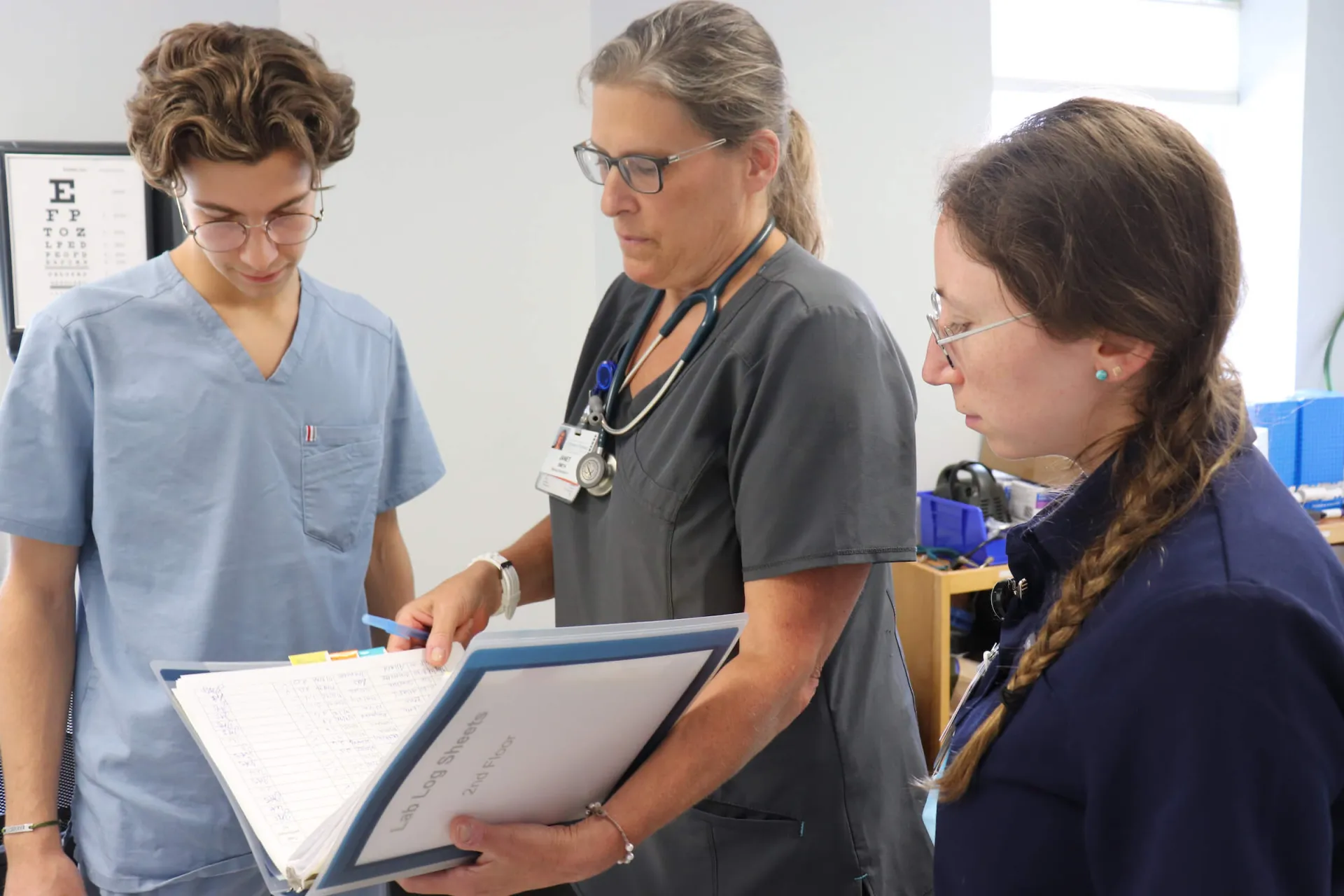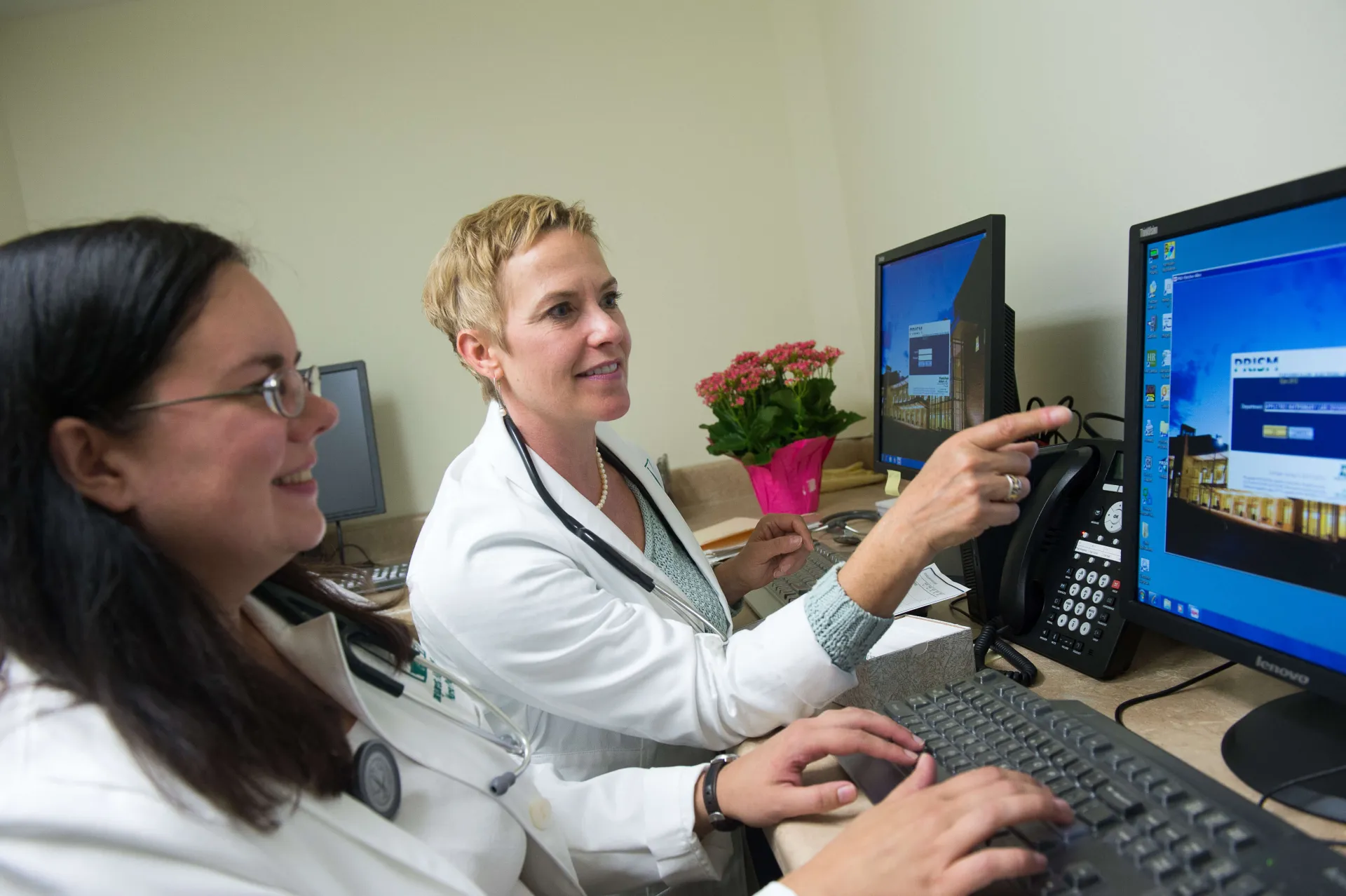
A Team of Professionals to Meet Patient Needs
The model draws from the scope of practice of each professional to jointly forge integrated plans of care that reflect patients’ individual needs and unique priorities. Interprofessional collaborative practice frequently includes patients’ families and often extends to the needs of communities.
Workshops and Events Core Competencies for Interprofessional Collaborative Practice (PDF)Interprofessional Education at the University of Vermont
Interprofessional education (IPE) is an approach to teaching and learning that brings together students from two or more professions to learn about, from and with each other in service of enabling effective collaboration. The goal of interprofessional education is to improve health outcomes through the education of a collaborative practice-ready workforce that is prepared to respond to local health needs. (World Health Organization, 2010)
Interprofessional education in the College of Nursing and Health Sciences supports learners in health professions programs to work together to cultivate knowledge and share responsibility for team-based holistic care of patients and clients in an increasingly more complex health care delivery system.
How Interprofessional Education Differs from Interprofessional Practice
Interprofessional practice occurs when multiple service providers from different professional backgrounds provide comprehensive healthcare or educational services by working with individuals and their families, caregivers, and communities- to deliver the highest quality of care across settings.
Interprofessional Educational Strategies and Facilities
Planned interprofessional learning experiences include the determination of educational strategies that best engage students from two or more health professions programs in a highly interactive and collaborative manner. The strategies include:
- Team based learning
- Case based Learning
- Simulation
- Virtual Clinic
- Faculty development
- Interprofessional coursework
In addition to traditional classroom settings interprofessional education sessions may take place within the University at a number of facilities including the Clinical Simulation Laboratory, the Given Outpatient Laboratory, the Larner Classroom, and Pomeroy Hall as well as off-campus clinical sites.
Clinical Simulation Laboratory
A collaborative effort of the UVM College of Medicine, the UVM College of Nursing and Health Sciences, and The University of Vermont Medical Center, the Clinical Simulation Laboratory is a centralized hub that brings together many different groups and constituencies, with the ultimate goal of improving quality and safety of care. The "Sim Lab" opened in the Rowell Building in March 2011, supported by a generous gift from the late Thomas Sullivan, M.D., a UVM alumnus from Etna, N.H., along with a $1.75 million federal grant secured by U.S. Senator Patrick Leahy.
The Clinical Simulation Laboratory is located on the second floor of the Rowell and Given Buildings on the University of Vermont campus and adjacent to The University of Vermont Medical Center. Located in 9,000 square feet of space are inpatient rooms, an ER/OR/MICU/SICU training room, skills labs, control center and debrief/meeting rooms. The outpatient rooms are just a corridor away, with 12 exam rooms set up to support simulated patient encounters using standardized patients and mannequin simulators. A satellite simulation lab is located at The University of Vermont Medical Center on the fifth floor of the McClure building, and a fully outfitted ambulance (the Simbulance) is also available for training.
Larner Classroom
Located at the front of the Dana Medical Library, the 2,820-square-foot Larner Classroom accommodates 120 students with flexibility for both small- and large-group functions. The Larner Classroom is made possible through a $1 million gift from alumnus Robert Larner, M.D.’42.
Pomeroy Hall
Pomeroy Hall is the site of the Eleanor M. Luse Center for Communication: Speech, Language and Hearing. The space provides an interprofessional simulation experiences for CSD, PT and nursing students in teams of four to interview and give recommendations to a standardized patient (SP) with swallowing and mobility issues related to ALS.
Leadership
- Director of Interprofessional Education: Mary Val Palumbo, D.N.P., APRN
- Associate Dean for Interprofessional Practice: Rosemary Dale, Ed.D., APRN, Chair, Department of Nursing
- Dean of the College of Nursing and Health Sciences: Noma Anderson, Ph.D
- IPE Team "Huddle Up" - Nancy LeMieux (Nursing/SIM Lab), Rebecca Oullette-Morton (Physical therapy), Danra Kazenski (Speech-language pathology)
- IPE committee 2022 - Mary Val Palumbo, Paula Smith, Kelly Tourville, Danra Kazenski, Victoria Priganc, Karen Lounsbury, Julie Ann Welkowitz, Rebecca Nagle, Farryl Bertmann
- Staff support - Christina Adamczak and Karina Lopez
Collaborative Partners
The College of Nursing and Health Sciences partners with The University of Vermont Medical Center to educate students in clinical areas that include laboratory science, nuclear medicine, and labor and delivery and to research issues such as worksite wellness and palliative care.
Funding Contributors
The College of Nursing and Health Sciences’ interprofessional education and collaborative practice initiatives are funded in part by a gift from Aline Demers, UVM Nursing Class of ’55 and former faculty member. The gift has been used to:
- Enhance interprofessional collaboration, a key element in providing patients and their families the best possible care
- Utilize the Clinical Simulation Laboratory for interprofessional activities
- Prepare faculty to teach interprofessional education
Contact Us
For more information:
Mary Val Palumbo DNP, APRN, GNP-BC, D
UVM College of Nursing and Health Sciences
Professor of Nursing
CNHS Director of Interprofessional Education
Email: mary.palumbo@med.uvm.edu

Faculty Development
In preparation for teaching interprofessional education, some College of Nursing and Health Sciences faculty attend programs put on by The National Center for Interprofessional Practice and Education. Numerous resources identified by IPE educators are available to further faculty development.
Faculty Development Resources
- TeamSTEPPS® is an evidence-based teamwork system aimed at optimizing patient care by improving communication and teamwork skills among health care professionals, including frontline staff. It includes a comprehensive set of ready-to-use materials and a training curriculum to successfully integrate teamwork principles into a variety of settings.
- Faculty Toolkit
- IPE Activity Examples from Texas Tech
- National Center for Interprofessional Practice and Education Resources
- Clinical Simulation Laboratory at the University of Vermont
Faculty Development Workshops
Faculty development workshops are offered twice a year by the UVM Clinical Simulation Laboratory. Contact Cate.Nicholas@med.uvm.edufor upcoming workshops.